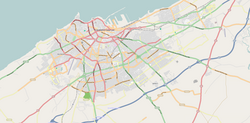Arrondissement of Casablanca in Casablanca-Settat, Morocco
Hay Mohammadi or Hay Mohammedi (Arabic: الحي المحمدي) is a neighbourhood in eastern Casablanca, in the Aïn Sebaâ - Hay Mohammadi district of the Casablanca-Settat region of Morocco. As of 2004 it had 156,501 inhabitants.[1]
The district was once home to North Africa's oldest and largest slum, formerly known as Carrières Centrales, which was largely demolished throughout the 2010s within the framework of the Moroccan government's 'Cities without Slums' (French: Villes sans bidonvilles; Arabic: مدن بلا أحياء فقيرة).[2] The project has been criticized for its forced relocation into unsustainable debts and relocating city dwellers away from their work and social sphere.[2][3]
This neighbourhood has been historically referred to as a 'mythical place', and locals talk about it with pride and affection. [2]
History
During the colonial era, the neighbourhood became a space for industrial and housing innovation. It was also famous for playing a crucial role in the anti-colonial struggle. In 1952, protests against the assassination of popular Tunisian labour leader Farhat Hached by French extremists were violently suppressed. Hundreds were killed by French troops.[2]
After the colonial period, during the reign of Hassan II of Morocco, the neighbourhood was the scene of protests and contestations of the monarch's power. As a response, the neighbourhood saw violent repression and the creation of an underground detention centre. As such, human rights abuses and violent state power were common during this period.[2][4]
During the 1980s, the neighbourhood saw a period of economic decline, as the removal of food subsidies and trade reforms led to massive job losses in the area.[2]
In the 2010s, through the relocation policies of the 'cities without slums' project many of the former inhabitants of Hay Mohammadi were resettled to Lahraouiyine, 10 kilometers outside of Casablanca's boundaries.[2]
Since 2019, the neighbourhood is served by line T2 of the Casablanca tramway.[2]
Population
The population of Hay Mohammedi consist by almost two-thirds of people between the ages of fifteen and twenty-nine. This causes tension and issues within society. A large number of these youth are unemployed and experience social and financial challenges on a daily basis. The male youth of Hay Mohammadi in the aftermath of street raids in 2014 was heavily targeted as criminals, 'Tcharmil'. In the course of these events, many NGOs were founded with the aim of supporting this group.[2]
